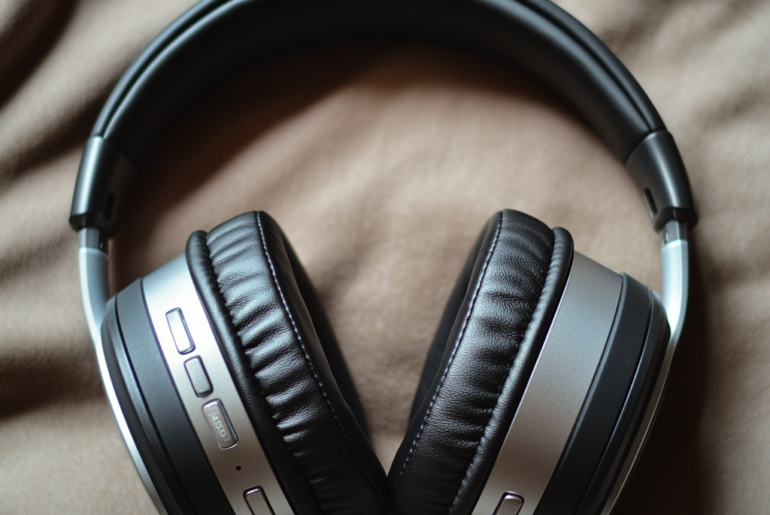This article may contain references to products or services from one or more of our advertisers or partners. We may receive compensation when you click on links to those products or services. Nonetheless, our opinions are our own.
As you slip on your noise-canceling headphones, blissfully shutting out the world around you, you might not be thinking about the potential risks of this immersive listening experience. Designed to block out sounds, these headphones are often praised as a modern marvel, providing the perfect escape into your favorite podcast or playlist. But have you ever considered whether their very function could negatively affect your hearing health? We’ll explore the nuanced relationship between noise-canceling technology and your auditory well-being. You’ll discover the science behind noise-canceling headphones, hear from experts, and uncover practical insights that could help you enjoy your music while protecting your ears. So, please take a moment to adjust those cushioned ear cups and join us as we delve into the possibly surprising implications that come with your cherished sound experience.
Understanding the Mechanics of Noise-Canceling Technology
Noise-canceling technology operates on a principle called active noise control (ANC). This system uses microphones to pick up external sounds, such as the hum of an airplane or chatter in a café. The headphones then generate sound waves that are the opposite—essentially “anti-noise” waves—that cancel out the unwanted sounds before they reach your ears. This creates an immersive experience, allowing you to focus on your music or podcast without distractions. However, it’s essential to understand how this technology can impact your hearing health.
As you regularly indulge in the convenience of ANC headphones, consider these factors:
- Volume levels: Many users may inadvertently raise the volume when using ANC, as the external noise is minimized.
- Long-Duration Use: Prolonged exposure to sound, even at lower volumes, can contribute to hearing fatigue.
- Dependence on ANC: Relying too heavily on noise-canceling features may make your ears less accustomed to natural sound environments.
To give you a better perspective, here’s a look at standard sound levels and their potential impact:
| Sound Level (dB) | Environment | Hearing Impact |
|---|---|---|
| 30 | Library | Safe for prolonged exposure |
| 85 | Heavy Traffic | Risk of hearing damage over time |
| 100 | Live Concert | Increased risk; limit exposure |
Recognizing the Risks: How Excessive Use Can Affect Your Hearing
It’s easy to get lost in your favorite playlist or podcast while wearing noise-canceling headphones, but have you ever stopped to consider the potential impact on your hearing? While these headphones can shield you from the clamor of the outside world, they can also inadvertently lead to a hazardous auditory environment if used excessively. The allure of immersive sound can tempt you to increase the volume; over time, this can contribute to hearing loss.
Consider the following points about the long-term use of noise-canceling headphones:
- Volume Levels: Prolonged exposure to sounds above 85 decibels can increase the risk of permanent hearing damage. Noise-canceling features often encourage users to increase volume, masking external sounds.
- Duration of Use: Listening to music for hours can fatigue your ears, making them less effective at processing sound and more susceptible to damage.
- Awareness of Environment: Wearing these headphones can create a false sense of security, causing you to miss critically important auditory cues in your surroundings, such as warnings or calls for attention.
A simple method to keep your hearing in check is following the 60/60 rule: listen at 60% volume for only 60 minutes. This approach can help mitigate risks while still allowing you to enjoy your favorite audio experiences without compromising your hearing health.
Finding the Balance: Safe Listening Habits for Everyday Use
Using noise-canceling headphones can enhance your listening experience, but you must adopt safe listening habits to protect your hearing. You might be tempted to increase the volume to drown out external noise, especially in loud environments. However, it’s crucial to be aware of the potential risks of prolonged exposure to high volumes. Here are some tips to help you find a healthy listening balance:
- Volume Control: Keep your volume at 60% or lower to minimize the risk of hearing loss.
- Listening Duration: Take breaks every hour to give your ears a rest.
- Awareness of Surroundings: Be mindful of your environment; avoid using noise-canceling headphones when you need to hear what’s happening around you.
- Invest in Quality: Choose headphones with built-in volume-limiting features.
To better understand the impact of listening habits, consider the following table highlighting safe volume levels and their corresponding exposure times:
| Volume Level (dB) | Safe Listening Time |
| 60 | Up to 8 hours |
| 70 | Up to 4 hours |
| 80 | Up to 2 hours |
| 90 | Up to 15 minutes |
Choosing the Right Noise-Canceling Headphones for Your Needs
When searching for the perfect pair of noise-canceling headphones, consider a few essential factors that align with your lifestyle and listening habits. First, assess the type of noise cancellation you need: Active Noise Cancellation (ANC) technology is excellent for blocking outside noise. Passive Noise Cancellation can help by creating a physical barrier between your ears and your environment. Each type serves different scenarios, such as commuting, working from home, or winding down in a busy café.
Next, think about comfort and fit. Can you wear your headphones for several hours without discomfort? The materials used in ear pads and the overall weight of the headphones can significantly impact your experience. Here are some key points to keep in mind:
- Sound Quality: Look for headphones that provide a balanced sound profile, especially in the low and mid ranges.
- Battery Life: Consider how long you need them to last on a single charge—some models offer over 30 hours!
- Additional Features: Features like touch controls, voice assistant compatibility, and transparency mode can enhance your overall experience.
Lastly, don’t forget to set a budget. Quality noise-canceling headphones come in various prices, so you want to find the best combination of features and affordability. The following table breaks down a few popular models to help you get started:
| Model | Type | Battery Life | Price Range |
| Model A | ANC | 30 hours | $150 – $200 |
| Model B | Passive | 25 hours | $100 – $150 |
| Model C | Hybrid | 40 hours | $250 – $300 |
Frequently Asked Questions
What are noise-canceling headphones, and how do they work?
Noise-canceling headphones reduce unwanted ambient sounds through active noise control. They use microphones to pick up external noises and produce sound waves that are the opposite, effectively canceling them out. This technology allows listeners to enjoy their music or podcasts at lower volumes.
Can noise-canceling headphones cause hearing damage?
The potential for hearing damage from noise-canceling headphones largely depends on the volume at which you listen to audio. Using them at high volumes can lead to the same risks as any other type of headphones. However, as they effectively reduce background noise, users might be tempted to turn up the volume higher than necessary, increasing the risk of hearing issues.
How can I use noise-canceling headphones safely?
To ensure safe use, keep the volume moderate, ideally below 60% of the maximum. Take regular breaks to give your ears a rest, and be mindful of your listening environment. If you find yourself in environments where you need to be aware of your surroundings, consider taking off the headphones or switching to ambient modes if available.

Reviewed and edited by Albert Fang.
See a typo or want to suggest an edit/revision to the content? Use the contact us form to provide feedback.
At FangWallet, we value editorial integrity and open collaboration in curating quality content for readers to enjoy. Much appreciated for the assist.
Did you like our article and find it insightful? We encourage sharing the article link with family and friends to benefit as well - better yet, sharing on social media. Thank you for the support! 🍉
Article Title: Are Noise-Canceling Headphones Quietly Damaging Your Hearing?
https://fangwallet.com/2025/03/09/are-noise-canceling-headphones-quietly-damaging-your-hearing/The FangWallet Promise
FangWallet is an editorially independent resource - founded on breaking down challenging financial concepts for anyone to understand since 2014. While we adhere to editorial integrity, note that this post may contain references to products from our partners.
The FangWallet promise is always to have your best interest in mind and be transparent and honest about the financial picture.
Become an Insider

Subscribe to get a free daily budget planner printable to help get your money on track!
Make passive money the right way. No spam.
Editorial Disclaimer: The editorial content on this page is not provided by any of the companies mentioned. The opinions expressed here are the author's alone.
The content of this website is for informational purposes only and does not represent investment advice, or an offer or solicitation to buy or sell any security, investment, or product. Investors are encouraged to do their own due diligence, and, if necessary, consult professional advising before making any investment decisions. Investing involves a high degree of risk, and financial losses may occur including the potential loss of principal.
Source Citation References:
+ Inspo
There are no additional citations or references to note for this article at this time.












































